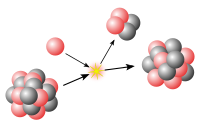
Photo from wikipedia
© 2021 American Chemical Society and Division of Chemical Education, Inc. A simple hands-on model for illustrating the concept of isotope dilution analysis (IDA) has been devised. The model consists… Click to show full abstract
© 2021 American Chemical Society and Division of Chemical Education, Inc. A simple hands-on model for illustrating the concept of isotope dilution analysis (IDA) has been devised. The model consists of two sets of beads of different sizes, with one set representing atoms of the analyte and the other set representing solvent water molecules. Phase separation is mimicked by sieving the beads, and the results are detected according to the color of the analyte beads. In this paper, the following three IDA methods are illustrated using the model: (1) direct IDA, (2) substoichiometric IDA, and (3) IDA-assisted neutron activation analysis. The model was demonstrated for a small group of graduate students with previous knowledge of nuclear chemistry, and the response from an inquiry held after the demonstration was good. It is suggested that the model can be used in a dry chemistry laboratory exercise to demonstrate the methodological differences between the different IDA methods, without the need for costly radioisotopes or irradiation facilities. It can also be used as a tool for engaging students in meta-modeling activities.
Journal Title: Journal of Chemical Education
Year Published: 2021
Link to full text (if available)
Share on Social Media: Sign Up to like & get
recommendations!